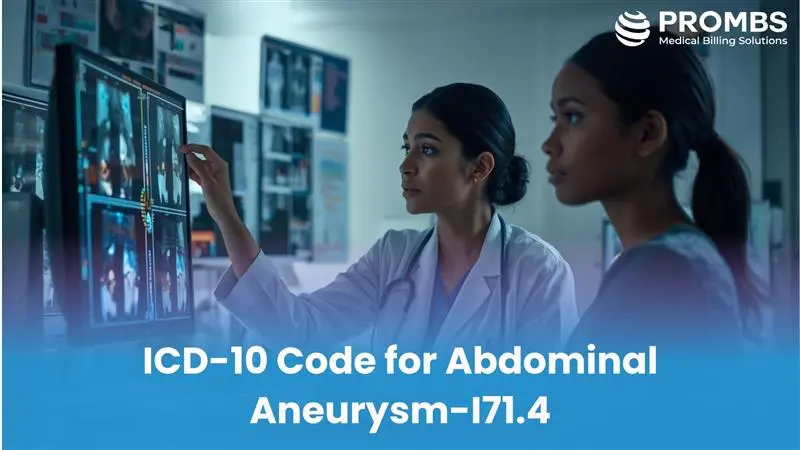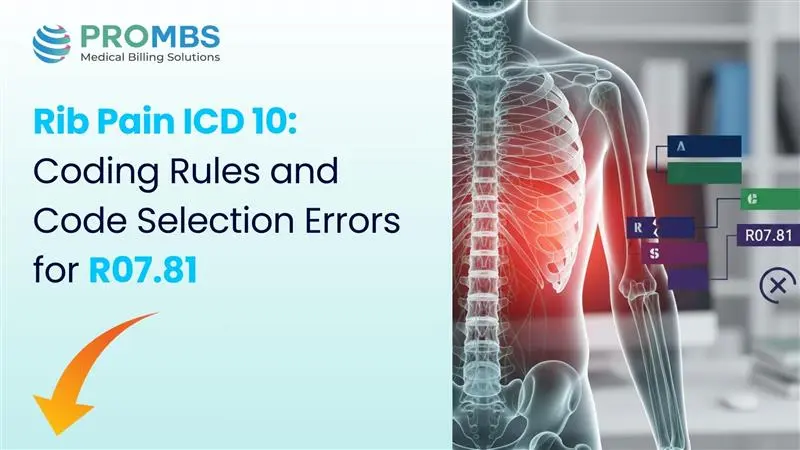An abdominal aneurysm, often called an abdominal aortic aneurysm (AAA), is a life-threatening condition where the abdominal aorta weakens and bulges. From a billing and compliance standpoint, it is one of the most scrutinized diagnoses because it often involves high-cost imaging, endovascular repairs, or open surgical procedures.
According to the Centers for Disease Control and Prevention (CDC), abdominal aortic aneurysms cause around 9,000 deaths annually in the United States, often due to rupture. Given this high morbidity and cost of care, insurers carefully review claims to ensure that the icd 10 code for abdominal aneurysm is accurate and directly supports the medical necessity of expensive CPT procedures like stent graft placement or surgical repair.
For coders, the challenge lies in selecting the correct ICD-10 subcode, documenting whether the aneurysm is ruptured or unruptured, and ensuring CPT pairing matches the documented intervention. Claims are frequently denied if coders default to unspecified codes or fail to distinguish rupture status.
What Is an Abdominal Aneurysm and Its Symptoms?
An abdominal aneurysm, also called an abdominal aortic aneurysm (AAA), is a bulging or dilation of the abdominal aorta, the largest artery in the body, due to weakening of its walls. The Mayo Clinic explains that AAAs are defined as aortic diameters greater than 3 cm, and they pose a severe risk of rupture if untreated.
Most patients remain asymptomatic until the aneurysm expands or ruptures, which is why accurate documentation and coding are crucial. When symptomatic, AAAs often present with persistent abdominal pain, back pain, or a pulsating mass, and in the event of rupture, patients may experience shock, hypotension, or sudden collapse. From a billing perspective, these symptoms must be clearly linked in the medical record to support the icd 10 code for abdominal aneurysm (I71.4) and justify diagnostic imaging or surgical CPT procedures.
| Symptom | Clinical Relevance | Coding/Billing Relevance |
|---|---|---|
| Abdominal/Back Pain | AAA may cause deep abdominal or lower back pain, often worsening with growth, as noted by the Cleveland Clinic. | Pain documentation supports medical necessity for imaging such as CT abdomen/pelvis (CPT 74176), which pairs with I71.4, per CMS ICD-10 guidelines. |
| Pulsating Abdominal Mass | A palpable pulsation is a hallmark finding described by the National Heart, Lung, and Blood Institute (NHLBI). | Justifies diagnostic ultrasound (CPT 76770) linked to I71.4, as outlined in Medicare billing manuals. |
| Hypotension/Shock | A classic sign of ruptured AAA, often fatal, emphasized by the American College of Cardiology. | Must be documented for correct coding of I71.3 (ruptured AAA), which supports emergent procedures like open repair, CPT 35081, per AMA CPT guidelines. |
| Asymptomatic Cases | Many AAAs are discovered incidentally on imaging, as explained by the U.S. Preventive Services Task Force (USPSTF). | Screening and incidental findings still require correct coding under I71.4, linked to imaging CPT codes, and must meet Medicare coverage rules. |
Did You Know? According to the Society for Vascular Surgery (SVS) , 90% of patients with ruptured abdominal aneurysms die before reaching the hospital or during emergency surgery. This staggering statistic highlights why documenting symptoms, even subtle ones like mild abdominal discomfort, is critical not only for patient survival but also for correct billing and denial prevention when applying the icd 10 code for abdominal aneurysm.
What Is the ICD-10 Code for Abdominal Aneurysm and What Does It Mean?
The icd 10 code for abdominal aneurysm falls under the I71 category: Aortic aneurysm and dissection within Chapter IX: Diseases of the Circulatory System (I00–I99). The most widely used code is I71.4-Abdominal aortic aneurysm, without rupture, but specificity is key: coders must document whether the aneurysm is ruptured vs unruptured, and whether it is thoracic, abdominal, or thoracoabdominal. The World Health Organization ICD-10 index and CMS ICD-10 guidelines both emphasize that coding rupture status is mandatory for compliance. Using unspecified codes or failing to distinguish rupture from non-rupture is a common cause of claim denials and OIG audit findings.
| ICD-10 Code | Meaning | Clinical Example | Coding & Billing Relevance |
|---|---|---|---|
| I71.3 | Abdominal aortic aneurysm, ruptured, defined in the WHO ICD-10 browser. | “Patient admitted with hypotension and CT confirmed a ruptured AAA,” per Mayo Clinic emergency guidelines. | Must be paired with surgical CPT codes such as 35081 (open repair), justified under AMA CPT rules. |
| I71.4 | Abdominal aortic aneurysm, without rupture, explained in ICD10Data. | “AAA discovered incidentally on abdominal ultrasound without rupture,” per Cleveland Clinic. | Supports elective repair claims, diagnostic imaging (74176 CT), and surveillance, validated by CMS coverage guidelines. |
| I71.5 | Thoracoabdominal aortic aneurysm, ruptured, listed in the WHO ICD-10 browser. | “Emergency rupture of thoracoabdominal aneurysm requiring open surgery,” noted in ACC clinical guidance. | Must link to emergent surgical CPT codes like 33877; rupture status is critical for Medicare reimbursement. |
| I71.6 | Thoracoabdominal aortic aneurysm, without rupture, included in ICD10Data. | “Elective stent-graft repair of thoracoabdominal aneurysm without rupture,” per Society for Vascular Surgery. | Supports CPT codes for EVAR (34802) when rupture is not present, following AMA CPT coding guidance. |
Did You Know? A study in the Journal of the American College of Cardiology found that ruptured AAAs carry a mortality rate exceeding 80%, while elective repair of unruptured AAAs has a significantly better outcome. This explains why coding rupture vs non-rupture status in the icd 10 code for abdominal aneurysm is not only clinically vital but also critical for billing compliance.
Which ICD-10 Chapter Includes Abdominal Aneurysm?
The icd 10 code for abdominal aneurysm is classified under Chapter IX: Diseases of the Circulatory System (I00–I99). This chapter captures cardiovascular conditions including hypertension, ischemic heart disease, stroke, and aneurysms. Within this chapter, abdominal aneurysms are located in the I71 block: Aortic aneurysm and dissection, which also includes thoracic and thoracoabdominal aneurysms. As emphasized by the CMS ICD-10-CM guidelines, coders must use chapter-specific rules such as Excludes1/Excludes2 notes to avoid double coding. For example, an abdominal aneurysm (I71.4) should not be coded together with thoracic aneurysm (I71.2) unless both conditions are documented separately.
| ICD-10 Chapter | Code Range | Where Abdominal Aneurysm Fits | Coding Insight |
|---|---|---|---|
| Chapter IX: Diseases of the Circulatory System | I00–I99 | This chapter includes all cardiovascular diseases such as heart disease, stroke, and aneurysms, explained in CDC ICD-10 guidance. | Abdominal aneurysm is grouped here because it represents a vascular condition of the aorta. Coders must apply circulatory system rules from CMS ICD-10 guidelines. |
| Block I71: Aortic Aneurysm and Dissection | I71.0–I71.9 | This block includes abdominal aneurysm codes like I71.3 (ruptured AAA) and I71.4 (unruptured AAA), as defined in the WHO ICD-10 browser. | Correct selection between I71.3 and I71.4 is critical for billing CPT procedures such as EVAR (34802), as documented in AMA CPT guidelines. |
| Specific Abdominal Aneurysm Codes | I71.3, I71.4 | These specify whether the aneurysm is ruptured vs unruptured, as detailed by ICD10Data. | Coders must not default to unspecified codes. Accuracy is essential to comply with payer audits and OIG billing compliance reports. |
Did You Know? The World Health Organization (WHO) reports that cardiovascular diseases, including aneurysms, remain the leading global cause of death, responsible for nearly 18 million deaths annually. This is why Chapter IX of ICD-10 is one of the most heavily scrutinized by insurers and auditors, and why precise coding of the icd 10 code for abdominal aneurysm is essential for both compliance and accurate patient care documentation.
Which CPT Codes Pair with the ICD-10 Code for Abdominal Aneurysm?
When coding for abdominal aneurysm, it is not enough to assign I71.3 (ruptured AAA) or I71.4 (unruptured AAA), coders must also correctly link these ICD-10 codes with the Current Procedural Terminology (CPT) codes that describe imaging, monitoring, or repair procedures. According to the American Medical Association (AMA), ICD-10 and CPT linkage is the backbone of proving medical necessity.The Centers for Medicare & Medicaid Services (CMS) regularly denies aneurysm claims when documentation does not clearly tie the ICD-10 code for abdominal aneurysm to the diagnostic or therapeutic service performed. For example, a CT abdomen (CPT 74176) billed without explicitly documenting “AAA confirmed on imaging” will often be rejected.
| CPT Code | Description | Typical ICD-10 Pairing | Documentation & Billing Insight |
|---|---|---|---|
| 74176 | CT abdomen and pelvis without contrast. | Used with I71.4 (abdominal aneurysm without rupture) as per ICD10Data. | Radiology reports must state aneurysm size and location, consistent with CMS coverage guidelines. |
| 76770 | Ultrasound, retroperitoneal, complete. | Linked with I71.4 for incidental or screening detection, supported by USPSTF AAA screening recommendations. | Documentation must specify if the study was preventive vs diagnostic, per Medicare billing rules. |
| 34802 | Endovascular repair of infrarenal AAA using modular bifurcated prosthesis. | Commonly paired with I71.4 (unruptured AAA) or I71.3 (ruptured AAA), per WHO ICD-10 browser. | Operative note must detail aneurysm site and rupture status to meet AMA CPT compliance. |
| 35081 | Open repair of infrarenal AAA with graft placement. | Specifically tied to I71.3 (ruptured AAA), explained in Cleveland Clinic AAA care. | Emergency notes must describe rupture and intraoperative findings; required by CMS audit standards. |
| 99291 | Critical care, evaluation and management of first 30–74 minutes. | Paired with I71.3 (ruptured abdominal aneurysm) for emergency stabilization, confirmed in ACC guidelines. | Documentation must capture time spent, interventions, and diagnosis, as required by OIG audit compliance. |
Did You Know? According to the Agency for Healthcare Research and Quality (AHRQ), AAA repairs account for over 45,000 inpatient procedures annually in the U.S.. Because of the high cost, insurers often audit claims linked to the icd 10 code for abdominal aneurysm to confirm accurate coding and proper CPT/ICD linkage.
What Are the Treatments for Abdominal Aneurysm?
Treatment for an abdominal aneurysm depends on aneurysm size, rupture status, and patient risk factors. Small AAAs may only require surveillance, while large or ruptured aneurysms require immediate repair. The Society for Vascular Surgery (SVS) recommends surgical intervention for aneurysms ≥5.5 cm in men or ≥5.0 cm in women, or any aneurysm that is symptomatic. From a billing perspective, the chosen treatment must be directly supported by ICD-10 coding (I71.3 ruptured, I71.4 unruptured) and CPT procedure codes. According to CMS coverage guidelines, vague or incomplete documentation (e.g., “AAA repair performed”) is a top cause of denials.
| Treatment Type | Clinical Application | ICD-10 Example | CPT Example | Documentation Insight |
|---|---|---|---|---|
| Surveillance & Monitoring | For small, stable AAAs (<5.5 cm) without symptoms, per Mayo Clinic. | I71.4 – Abdominal aortic aneurysm without rupture, defined in WHO ICD-10. | 99213 – Office visit, described by AMA CPT guidance. | Providers must document aneurysm size, growth rate, and follow-up imaging plan, as required in CMS compliance rules. |
| Endovascular Aneurysm Repair (EVAR) | Minimally invasive stent grafting, recommended by SVS guidelines. | I71.4 (unruptured AAA) or I71.3 (ruptured AAA), per ICD10Data. | 34802 – Endovascular repair of infrarenal AAA, listed in AMA CPT codebook. | Operative note must specify aneurysm site, rupture status, and device used. Missing detail is a common denial flag in OIG audits. |
| Open Surgical Repair | Emergency or elective open graft placement, explained by Cleveland Clinic. | I71.3 – Abdominal aortic aneurysm, ruptured, documented in WHO ICD-10. | 35081 – Open repair of infrarenal AAA, validated in J Vascular Surgery. | Documentation must include rupture confirmation, graft type, and intraoperative details to meet CMS audit standards. |
| Risk Factor Management | Hypertension and smoking control, per American Heart Association. | I71.4 – Unruptured AAA, paired with risk factor codes (e.g., I10 – Essential hypertension) from CDC ICD-10 guidance. | 99214 – Office visit with management plan, described by AMA CPT rules. | Must show linkage between AAA and comorbidities (e.g., hypertension, smoking) to justify risk-reduction therapy claims. |
How Should Documentation Be Structured to Avoid Denials?
| Documentation Pitfall | Why It Causes Denials | Best Practice Example |
|---|---|---|
| “AAA present” with no detail | Too vague; payers cannot validate medical necessity for repair. | “5.8 cm infrarenal abdominal aortic aneurysm, without rupture (I71.4), confirmed on CT abdomen (CPT 74176).” |
| Rupture status not documented | Insurers cannot determine urgency or correct ICD-10. | “Ruptured AAA (I71.3) documented with hypotension and emergent open repair (CPT 35081).” |
| Laterality or location omitted | Payers require anatomical specificity when possible. | “Thoracoabdominal aneurysm without rupture (I71.6) repaired via EVAR (CPT 34802).” |
| CPT billed without ICD-10 linkage | No proof of medical necessity; flagged in audits. | “AAA repair (CPT 34802) linked to diagnosis I71.4 as documented on operative note.” |
| Use of unspecified codes | Auditors reject claims when provider documented details are ignored. | Always assign the most specific ICD-10 (e.g., I71.3 ruptured vs I71.4 unruptured), aligned with WHO ICD-10 browser. |
Did You Know? The Office of Inspector General (OIG) found that over 25% of denied vascular surgery claims involved insufficient documentation, most often because rupture status or imaging measurements were missing. By ensuring that every abdominal aneurysm claim captures size, rupture status, CPT/ICD linkage, and medical necessity, providers can dramatically reduce denial risk and strengthen audit protection.
Why Should Providers Partner with PROMBS for Abdominal Aneurysm Billing?
Abdominal aortic aneurysm (AAA) billing is one of the most compliance-sensitive areas in vascular coding. Claims often involve high-cost procedures such as endovascular aneurysm repair (EVAR) or open surgical grafting, which are closely audited by payers. According to the Centers for Medicare & Medicaid Services (CMS), improper Medicare payments totaled $31.7 billion in FY 2024, with vascular and cardiovascular services among the most scrutinized.
PROMBS specializes in helping providers eliminate these risks. By combining ICD-10 coding accuracy, CPT pairing expertise, and denial prevention workflows, we make sure that claims for the icd 10 code for abdominal aneurysm (I71.3, I71.4, I71.5, I71.6) are accurate, audit-ready, and optimized for revenue integrity.



